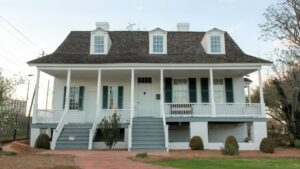 The Meadow Garden Historic Site is located near downtown Augusta, Georgia. It is operated as a museum and park by the city of Augusta. The house was built in 1795 by George Walton, who served as Governor of Georgia from 1816-1820. It was designated a National Historic Landmark in 1964 for its exceptional Greek Revival architecture, which features Ionic columns, Palladian windows and a brick façade with Federalist details. You can visit this amazing destination at 1320 Independence Dr, Augusta, GA 30901.
The Meadow Garden Historic Site is located near downtown Augusta, Georgia. It is operated as a museum and park by the city of Augusta. The house was built in 1795 by George Walton, who served as Governor of Georgia from 1816-1820. It was designated a National Historic Landmark in 1964 for its exceptional Greek Revival architecture, which features Ionic columns, Palladian windows and a brick façade with Federalist details. You can visit this amazing destination at 1320 Independence Dr, Augusta, GA 30901.
In 1798, George Walton emerged as a prominent political figure in Georgia. He served as a state legislator, state supreme court judge, and state attorney general before being elected governor. During his term, he advocated for a padlock law to penalize people who neglected to lock their carriages when parking on streets. This law was proposed to address the problem of street congestion, which was caused by drivers stopping to walk their horses or keep them company while parked. Walton also advocated for a state lottery, which garnered him some criticism. A contemporary newspaper described Walton as “a rascally fellow, and a great coward at the same time.” In 1811, Walton was defeated in his bid to be elected to the United States Senate. Later that same year, he died at the age of 48 from pancreatic cancer. Walton Street in Augusta is named after him.
The Meadow Garden Historic Site is a 18th-century historic house museum in Augusta, Georgia. It was the home of politician George Walton, who served as Governor of Georgia from 1816-1820. It was designated a National Historic Landmark in 1964 for its exceptional Greek Revival architecture, which features Ionic columns, Palladian windows and a brick façade with Federalist details. The site also includes a restored cottage and garden. The historic house is located near downtown Augusta and is operated as a museum and park by the city of Augusta. The house was built in 1795 by George Walton, who served as Governor of Georgia from 1816-1820. It was designated a National Historic Landmark in 1964 for its exceptional Greek Revival architecture, which features Ionic columns, Palladian windows and a brick façade with Federalist details. The site also includes a restored cottage and garden.
Greek Revival architecture is a sub-style of Georgian architecture that was popular in the mid-18th century. During the period of its popularity, it was particularly associated with The United Kingdom and its colonies in the West Indies. It was a reaction against the Baroque style of architecture, which had been popular in the mid-17th century. The Greek Revival, therefore, is generally understood to be a reaction against the Baroque style. Greek Revival architecture used the classical forms of the buildings of ancient Greece as a reference point. The architecture of vernacular Greek buildings was imitated by luxury architects in hopes of achieving inspiration from the best examples of ancient architecture.
The historic house is located near downtown Augusta and is operated as a museum and park by the city of Augusta. The house was built in 1795 by George Walton, who served as Governor of Georgia from 1816-1820. It was designated a National Historic Landmark in 1964 for its exceptional Greek Revival architecture, which features Ionic columns, Palladian windows and a brick façade with Federalist details. The site also includes a restored cottage and garden. The historic house is located near downtown Augusta and is operated as a museum and park by the city of Augusta. The house was built in 1795 by George Walton, who served as Governor of Georgia from 1816-1820. It was designated a National Historic Landmark in 1964 for its exceptional Greek Revival architecture, which features Ionic columns, Palladian windows and a brick façade with Federalist details. The site also includes a restored cottage and garden.
The historic house is located near downtown Augusta and is operated as a museum and park by the city of Augusta. It was built in 1795 by George Walton, who served as Governor of Georgia from 1816-1820. It was designated a National Historic Landmark in 1964 for its exceptional Greek Revival architecture, which features Ionic columns, Palladian windows and a brick façade with Federalist details. The site also includes a restored cottage and garden. The historic house is located near downtown Augusta and is operated as a museum and park by the city of Augusta. It was built in 1795 by George Walton, who served as Governor of Georgia from 1816-1820. It was designated a National Historic Landmark in 1964 for its exceptional Greek Revival architecture, which features Ionic columns, Palladian windows and a brick façade with Federalist details. The site also includes a restored cottage and garden.
Driving Directions To Savy Space Self Storage From Meadow Garden
Driving Directions To Augusta Museum of History